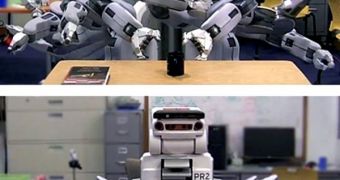When we reach for a mug on the table, our brains are kind enough to plot a course for our hands that takes them beyond obstacles, yet on the most efficient paths. Doing the same thing for robots has thus far proven to be a tremendously complex task, but one that has finally been completed.
Researchers at the Massachusetts Institute of Technology (MIT), in Cambridge, say that the new algorithms and computational abilities they instilled in their robots enable the machines to plot predictable, efficient courses through open space.
While this may seem like nothing for us, robots have a very tough time doing this. If a humanoid machine keeps its hands on its knees below the surface of the table, reaching out and grabbing a mug becomes a tragicomic spectacle to watch.
Conflicting commands and readings from the environment make the machine stumble and stutter for seconds on end, until finally it understands what the proper course of action should be. The MIT team developed a method of allowing machines to do this constantly, efficiently and quick.
At this point, most motion-planning algorithms installed in robots are focused on avoiding collisions with environmental obstacles, rather than on collisions. But the US researchers now make two innovative algorithms available for conducting this task.
The team was made up of experts at the MIT Computer Science and Artificial Intelligence Laboratory (CSAIL) and the Laboratory for Information and Decision Systems (LIDS). The most important breakthrough is introducing planning efficiency without sacrificing safety.
Details of the tremendous achievement will be presented later this month at the Institute of Electrical and Electronics Engineers’ (IEEE) International Conference on Intelligent Robots and Systems.
“You’d expect [robots] to execute some form of optimal path. The problem with most motion planners is that while they’re very good at finding feasible solutions for very complex systems, they’re not very good at finding optimal paths,” CSAIL researcher and study coauthor Matthew Walter explains.
At this time, the MIT group is preparing to embark on an effort to optimize the system, increasing the speed at which the two algorithms produce results. Oftentimes, analysts explain, doing so is only a matter of improving the code lines.
Video description: This is a comparison video showing the performances of the new algorithms, when compared to those of existing ones Video credit: MIT

 14 DAY TRIAL //
14 DAY TRIAL //